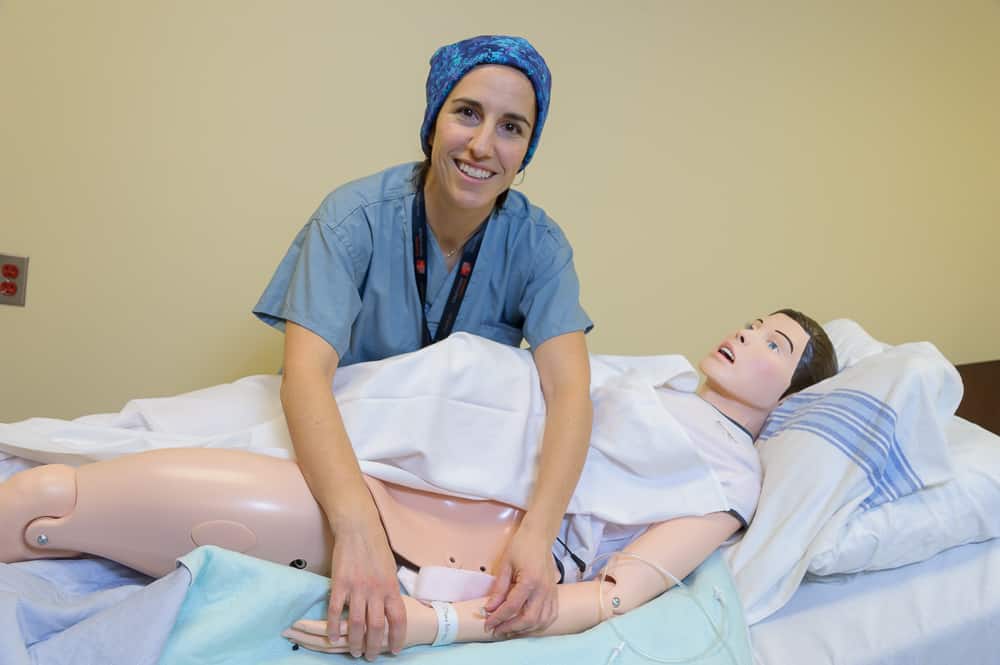High-tech mannequin trains staff for emergency obstetric situations
While many of us know that Code Blue means cardiac arrest, fewer of us know what Code Pink means: a woman having a baby is in crisis.
Over a recent 18-month period nurses, obstetricians and anesthesiologists at St. Paul’s responded to 49 Code Pinks. That’s about three pregnancies a month that required emergency procedures, in many cases to save the life of the mother, the baby, or both.
St. Paul’s anesthesiologist Dr. Trina Montemurro describes what a Code Pink is like. “Over the P.A. we hear, ‘Code Pink, O.R.’ which means at that moment the obstetrics team is running down the hall from Maternity to the O.R. with a mom who needs an emergency C-section. It happens very fast. It could happen right now.”
With an emergency procedure about to be administered, often decided on the spot, Dr. Montemurro is quick to point out the importance of communication in the midst of a crisis.
“There is a handing over of communication between the obstetricians, the anesthesiologist, the maternity nurses and the OR nurses where we transition this patient from having her baby in Maternity to now having an operation. This is a great deal of change in a very short period of time.”
It is this dynamic that makes simulation exercises such a valuable learning experience for care teams. In Dr. Montemurro’s case, she refers to SimMom, a maternity and fetus specific simulator that helps to train care teams to deal with emergencies.
Try to imagine a high-tech crash test dummy that can moan and cry—and deliver a simulated baby.
It’s all “very real”
While SimMom is, on the surface, a giant mannequin lying on a gurney, once she has been hooked up to the appropriate machines and monitors, she starts to seem very real. SimMom is hooked up to an IV, and specific doses of drugs must be put into her veins. She has an airway for a breathing tube, which mimics the physiological differences of a pregnant woman’s airway.
“This is a critical difference,” says Dr. Montemurro, “and that is what’s great about having a unit specific to obstetrics simulation exercises. In real life, if you can’t get that breathing tube in, mom’s life is in danger.”
SimMom also has vital signs like heart rate and blood pressure and even has a voice box that makes noises when she is in distress because that’s what real moms do.
Add to this two maternity nurses, two OR nurses, an anesthesiologist, a pediatric nurse, a pediatrician, an obstetrician and an OB resident, all of whom are crowded around SimMom’s bed with a job to do—and yes, says Dr. Montemurro, “it can all feel very real.”
Simulation provides opportunities for learning
The SimMom program is directed by anesthesiologist Dr. Laine Bosma, who has expertise in designing, implementing and supervising simulation programs to help care teams deal with crisis.
Dr. Montemurro says that you may think you’re communicating effectively during an emergency, but you may not be. This is a focus of the debrief session that follows the simulation exercise.
“Dr. Bosma will ask me, ‘Trina, when they arrived in the OR, what do you remember hearing?’ And I’ll tell him I heard this and this. And he will say, ‘Anything else? Do you remember someone saying this about the IV?’ And it will dawn on me. No, I didn’t hear that.”
Dr. Montemurro says the SimMom exercise is highly realistic and an invaluable learning experience.
“When you make a mistake in a simulation like this,” she says, “there’s a very good chance you won’t make that mistake again.”
St. Paul’s Foundation’s Lights of Hope Greatest Needs fund provided $125,000 to support the Code Pink Simulation Project, with $38,000 to cover the cost of the SimMom unit and the remaining amount to support programming costs over the next three years.
